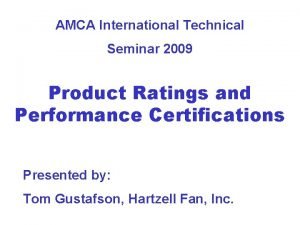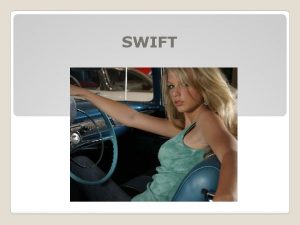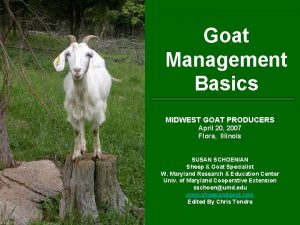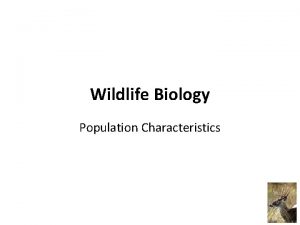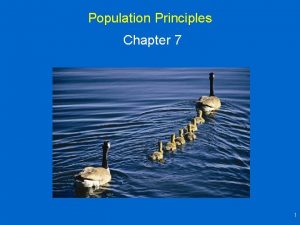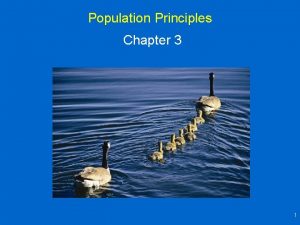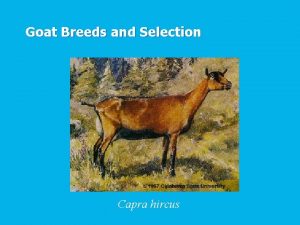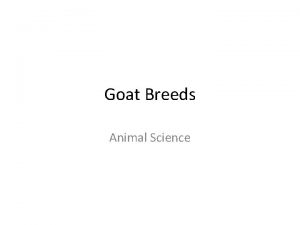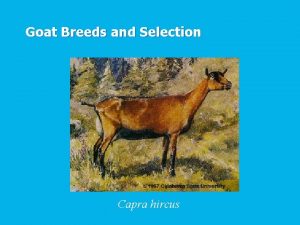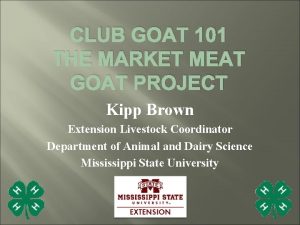Goat Management Characteristics n Goat population worldwide is






































- Slides: 38

Goat Management

Characteristics n Goat population worldwide is over 350 million n U. S. population is between 2 & 3 million n Becoming more popular as people move to more rural areas n Relatively inexpensive to purchase and reproduces efficiency n n Having 2 - 3 offspring per year Don’t demand specialized housing or feedstuff

Patterning n Get does into a routine. Feed at same time and place where you can pen the animals in a small enclosure. n Easily caught and handled from there.

Reproduction n Seasonal Breeders n Length of daylight influences the secretion of hormones that affect the estrous cycle n Seasonal species are responsive to melatonin n Hormone produced by the pineal gland Response to declining periods of light Breed in the Fall n 80% of all does come into heat between Sept 1 and Dec 31

Reproduction n 3 systems for breeding n Pasture Breeding n AI n Hand Mating

Pasture Breeding n Does and Buck put into one field n Very little labor and results in a large percentage of does conceiving n Have no control over when does are bred

AI n Growing in popularity n Frozen semen is thawed and placed into the reproductive tract of the doe n Done by using a plastic insemination pipette n Heat detection is very important n Cost is higher n Can breed to superior bucks

Insemination site Ø We want the tip of the catheter to be well inside the cervix, but not penetrate completely into the uterus. Ø Reason-bacterial contamination

Take catheter and insert

Place catheter in cervix

Hand Mating n Buck is kept in a separate pen from the does n As does come into heat they are turned into pen with buck n Breeding is observed, then doe is removed from buck and return to pen n Gives you precise breeding dates n Separate buck pen and shed, and more time is involved

Parturition n Gestation period is between 145 - 155 days n Kids should have navels dipped in iodine to prevent infection n Make sure kids receive colostrum n Don’t touch kids right after birth n Kids are weaned at 3 months

Disbudding n Removal of the horn buds from a kid n Two methods n Chemical n Disbudding iron

Castration n Done before 12 weeks n 3 methods n Knife n Burdizzo n Elastrator

Knife

Burdizzo

Elastrator

Identification n 4 different methods n Tattooing n Neck chains n Branding n Ear notching

Hoof trimming n Removing the excess growth that occurs at the toes, heels, and sidewalls of the hooves n Should be done every 6 -8 weeks


Hoof Trimming

Parasites n Internal Parasites one of most economically important constraints in raising livestock n Animals certain to exposure of worms Confinement n Pasture-based n n Results n Decrease in productivity n death

Controlling Parasites n Worms are a major parasite within goat industry n Should be dewormed on a regular basis n About every 6 -8 weeks n Receive an injection of Clostridium Perfringes, Types C & D and Tetnus, once a year

Deworming n 3 types of dewormers n Avermectin n Benzimidazoles n Imidazothiazole

Avermectin n Clear dewormers n Ivomec, Dectomax, Cydectin n Not effective against tapeworms

Benzimidazoles n White dewormers n Safeguard n Effective against tapeworms n Can cause abortions

Imidazothiazole n Tramisol n May cause abortions n The “safe” and “toxic” levels are very close, making product dangerous

Fecal Float n Way to identify what type of worms goats have and what you need to vaccinate with n Use a Modified Wisconsin Procedure n Create a sucrose solution n n Combine 454 g granulated sugar with 335 m. L of water Heat the solution until the sugar is completely dissolved and the solution is clear

Fecal Float n Fecal samples are collected and weighed n 3 g of each sample is measured and suspended into 20 m. L of the sucrose solution in a waxed paper cup n Solution is stirred until solution is completely dispersed and then poured into a second cup


Fecal Float n Liquid is poured into a 15 m. L test tube until slightly raised above the top of the test tube then topped with a cover slip n Allow to sit for 3 -6 hours then observe under a microscope

The FAMACHA© System n Eye color chart with five color categories n Compare chart with color of mucous membranes of sheep or goat n Classification into one of five color categories: • • 1 – not anemic 5 -- severely anemic

n Examine in sunlight n Open as shown - for a short time only n Look at color inside lower eyelid

n Barber pole worm egg

n Haemonchus adults in the abomasum


Other Diseases n Blackleg n Bloat n Bottle Jaw n Coccidiosis n Colic n Enterotoxaemia n Foot and Mouth Disease n Foot Rot

Other Diseases n Johne’s Disease n Thickening of intestine n Have to be slaughtered (no cure) n Pregnancy toxemia n Mastitis n Tetanus n Urinary Calculi
 Chapter 4 population ecology worksheet answer key
Chapter 4 population ecology worksheet answer key Population ecology section 1 population dynamics
Population ecology section 1 population dynamics Population ecology section 1 population dynamics
Population ecology section 1 population dynamics Chapter 4 section 1 population dynamics
Chapter 4 section 1 population dynamics Wise foundation
Wise foundation Worldwide telescope online
Worldwide telescope online Bp 401
Bp 401 Fsi worldwide kenya ltd
Fsi worldwide kenya ltd Are countrywide and worldwide networks
Are countrywide and worldwide networks Church of god a worldwide association
Church of god a worldwide association Amca certification reviews
Amca certification reviews Worldwide product division structure
Worldwide product division structure Worldwide lhc computing grid
Worldwide lhc computing grid Wipo dl-101 final exam questions
Wipo dl-101 final exam questions Caterpillar dealers worldwide
Caterpillar dealers worldwide Society of worldwide interbank financial telecommunication
Society of worldwide interbank financial telecommunication What impact does the ocean have on climate brainpop
What impact does the ocean have on climate brainpop Church of god worldwide association
Church of god worldwide association Reasons for accounting diversity
Reasons for accounting diversity Color 08242004
Color 08242004 Leveraging subsidiary skills
Leveraging subsidiary skills Biz worldwide (pvt) ltd
Biz worldwide (pvt) ltd Organizational subunits
Organizational subunits 5 voices assessment
5 voices assessment Profi hub
Profi hub Worldwide logistics
Worldwide logistics Worldwide reach human touch
Worldwide reach human touch Eagle worldwide ministries
Eagle worldwide ministries Worldwide interoperability for microwave access
Worldwide interoperability for microwave access Worldwide interoperability for microwave access (wimax)
Worldwide interoperability for microwave access (wimax) Worldwide espacenet
Worldwide espacenet In worldwide
In worldwide Pfizer wrd
Pfizer wrd Worldwide one person in every experiences persistent hunger
Worldwide one person in every experiences persistent hunger Hellmann worldwide logistics
Hellmann worldwide logistics Data access worldwide
Data access worldwide Coffee production worldwide
Coffee production worldwide Worldwide mentorship
Worldwide mentorship Discussion questions about entrepreneurship
Discussion questions about entrepreneurship










